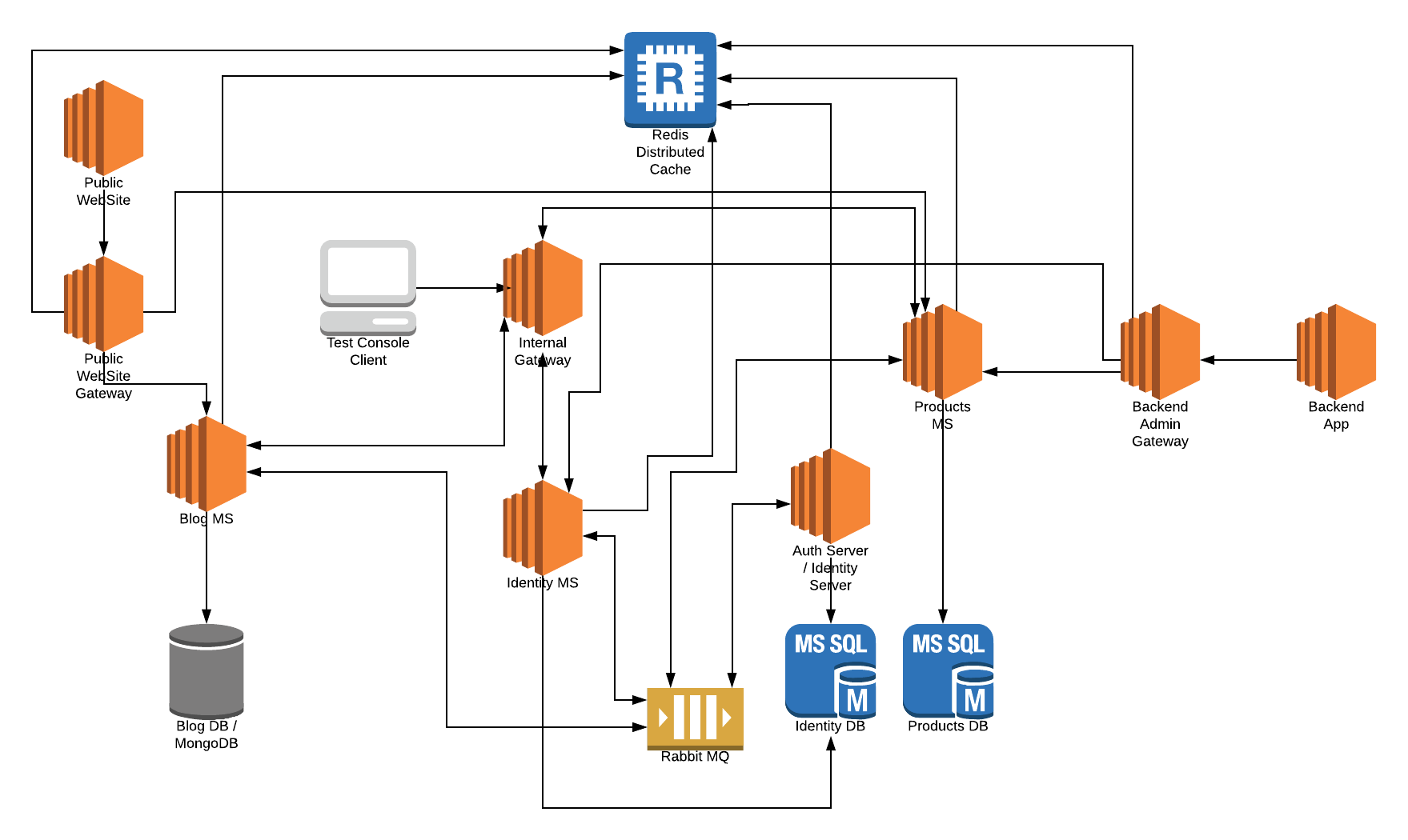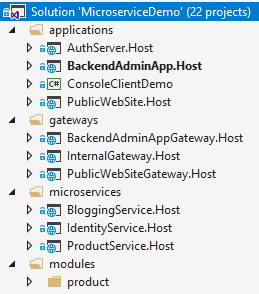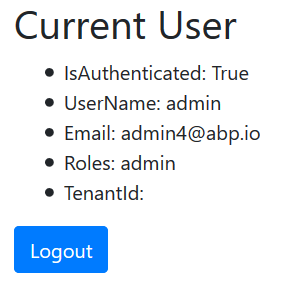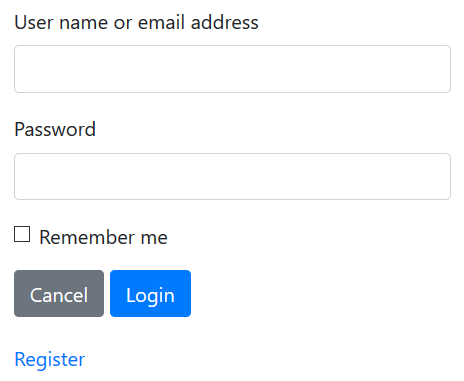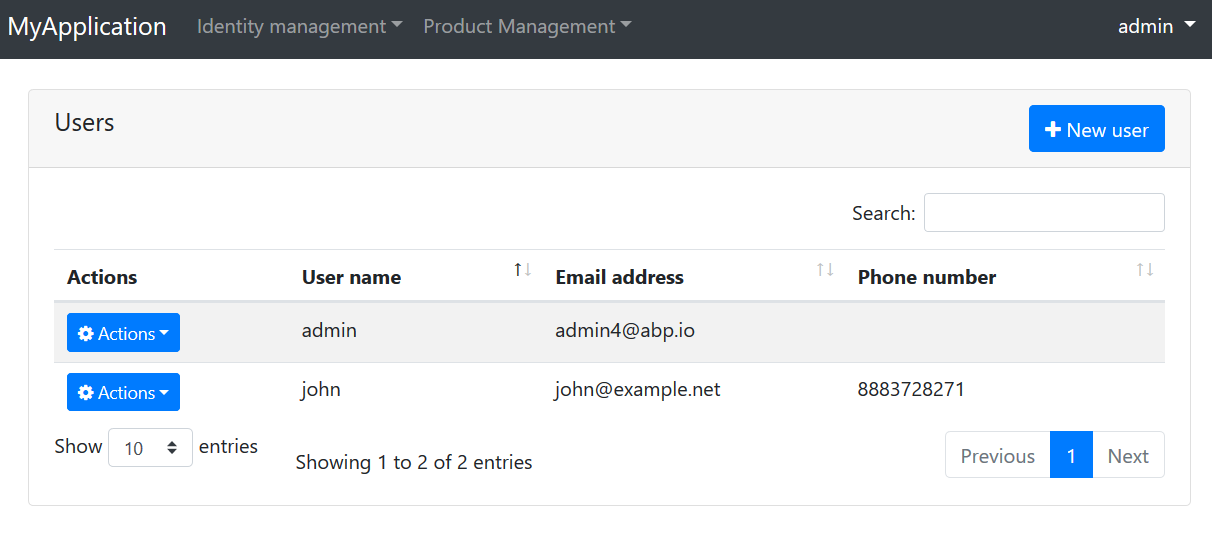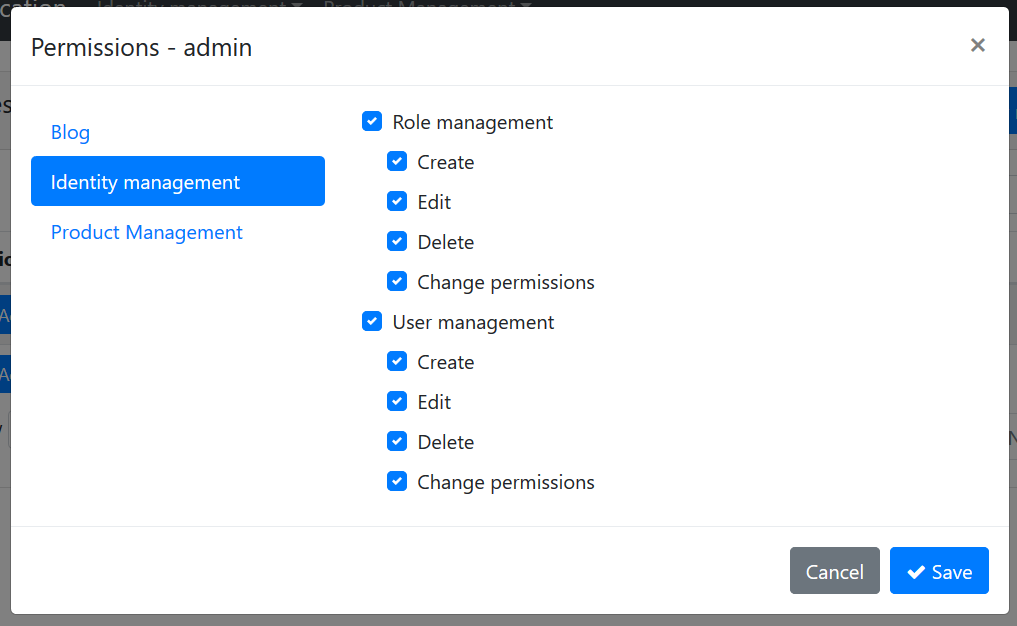39 KiB
Microservice Demo Solution
"Microservices are a software development technique—a variant of the service-oriented architecture (SOA) architectural style that structures an application as a collection of loosely coupled services. In a microservices architecture, services are fine-grained and the protocols are lightweight. The benefit of decomposing an application into different smaller services is that it improves modularity. This makes the application easier to understand, develop, test, and become more resilient to architecture erosion. It parallelizes development by enabling small autonomous teams to develop, deploy and scale their respective services independently. It also allows the architecture of an individual service to emerge through continuous refactoring. Microservices-based architectures enable continuous delivery and deployment."
Introduction
One of the major goals of the ABP framework is to provide a convenient infrastructure to create microservice solutions.
This sample aims to demonstrate a simple yet complete microservice solution;
- Has multiple, independent, self-deployable microservices.
- Multiple web applications, each uses a different API gateway.
- Has multiple gateways / BFFs (Backend for Frontends) developed using the Ocelot library.
- Has an authentication service developed using the IdentityServer framework. It's also a SSO (Single Sign On) application with necessary UIs.
- Has multiple databases. Some microservices has their own database while some services/applications shares a database (to demonstrate different use cases).
- Has different types of databases: SQL Server (with Entity Framework Core ORM) and MongoDB.
- Has a console application to show the simplest way of using a service by authenticating.
- Uses Redis for distributed caching.
- Uses RabbitMQ for service-to-service messaging.
- Uses Docker & Kubernates to deploy & run all services and applications.
- Uses Elasticsearch & Kibana to store and visualize the logs (written using Serilog).
The diagram below shows the system:
Source Code
You can get the source code from the GitHub repository.
Status
This sample is still in development, not completed yet.
Running the Solution
You can either run from the source code or from the pre-configured docker-compose file.
Using the Docker Containers
Pre Requirements
Running as docker containers is easier since all dependencies are pre-configured. You only need to install the latest docker.
Running Containers
-
Clone or download the ABP repository.
-
Open a command line in the
samples/MicroserviceDemofolder of the repository. -
Restore SQL Server databases:
docker-compose -f docker-compose.yml -f docker-compose.migrations.yml run restore-database -
Start the containers:
docker-compose up -dAt the first run, it will take a long time because it will build all docker images.
-
Add this line to the end of your
hostsfile:127.0.0.1 auth-serverhosts file is located inside the
C:\Windows\System32\Drivers\etc\hostsfolder on Windows and/etc/hostsfor Linux/MacOS.
Run the Applications
There are a few applications running in the containers you may want to explore:
- Backend Admin Application (BackendAdminApp.Host):
http://localhost:51512(Used to manage users & products in the system) - Public Web Site (PublicWebsite.Host):
http://localhost:51513(Used to list products and run/manage the blog module) - Authentication Server (AuthServer.Host):
http://auth-server:51511/(Used as a single sign on and authentication server built with IdentityServer4) - Kibana UI:
http://localhost:51510(Use to show/trace logs written by all services/applications/gateways)
Running From the Source Code
Pre Requirements
To be able to run the solution from source code, following tools should be installed and running on your computer:
- SQL Server 2015+ (can be express edition)
- Redis 5.0+
- RabbitMQ 3.7.11+
- MongoDB 4.0+
- ElasticSearch 6.6+
- Kibana 6.6+ (optional, recommended to show logs)
Open & Build the Visual Studio Solution
- Open the
samples\MicroserviceDemo\MicroserviceDemo.slnin Visual Studio 2017 (15.9.0+). - Run
dotnet restorefrom the command line inside thesamples\MicroserviceDemofolder. - Build the solution in Visual Studio.
Restore Databases
Open MsDemo_Identity.zip and MsDemo_ProductManagement.zip inside the samples\MicroserviceDemo\databases folder and restore to the SQL Server.
Notice that: These databases have EF Core migrations in the solution, however they don't have seed data, especially required for IdentityServer4 configuration. So, restoring the databases is much more easier.
Run Projects
Run the projects with the following order (right click to each project, set as startup project an press Ctrl+F5 to run without debug):
- AuthServer.Host
- IdentityService.Host
- BloggingService.Host
- ProductService.Host
- InternalGateway.Host
- BackendAdminAppGateway.Host
- PublicWebSiteGateway.Host
- BackendAdminApp.Host
- PublicWebSite.Host
A Brief Overview of the Solution
The Visual Studio solution consists of multiple projects each have different roles in the system:
Applications
These are the actual applications those have user interfaces to interact to the users and use the system.
- AuthServer.Host: Host the IdentityServer4 to provide an authentication service to other services and applications. It is a single-sign server and contains the login page.
- BackendAdminApp.Host: This is a backend admin application that host UI for Identity and Product management modules.
- PubicWebSite.Host: As public web site that contains a simple product list page and blog module UI.
- ConsoleClientDemo: A simple console application to demonstrate the usage of services from a C# application.
Gateways / BFFs (Backend for Frontend)
Gateways are used to provide a single entry point to the applications. It can also used for rate limiting, load balancing... etc. Used the Ocelot library.
- BackendAdminAppGateway.Host: Used by the BackendAdminApp.Host application as backend.
- PublicWebSiteGateway.Host: Used by the PublicWebSite.Host application as backend.
- InternalGateway.Host: Used for inter-service communication (the communication between microservices).
Microservices
Microservices have no UI, but exposes some REST APIs.
- IdentityService.Host: Host the ABP Identity module which is used to manage users & roles. It has no additional service, but only hosts the Identity module's API.
- BloggingService.Host: Host the ABP Blogging module which is used to manage blog & posts (a typical blog application). It has no additional service, but only hosts the Blogging module's API.
- ProductService.Host: Hosts the Product module (that is inside the solution) which is used to manage products. It also contains the EF Core migrations to create/update the Product Management database schema.
Modules
- Product: A layered module that is developed with the module development best practices. It can be embedded into a monolithic application or can be hosted as a microservice by separately deploying API and UI (as done in this demo solution).
Databases
This solution is using multiple databases:
- MsDemo_Identity: An SQL database. Used SQL Server by default, but can be any DBMS supported by the EF Core. Shared by AuthServer and IdentityService. Also audit logs, permissions and settings are stored in this database (while they could easily have their own databases, shared the same database to keep it simple).
- MsDemo_ProductManagement: An SQL database. Again, used SQL Server by default, but can be any DBMS supported by the EF Core. Used by the ProductService as a dedicated database.
- MsDemo_Blogging: A MongoDB database. Used by the BloggingService.
- Elasticsearch: Used to write logs over Serilog.
Applications
Authentication Server (AuthServer.Host)
This project is used by all other services and applications for authentication & single sign on. Mainly, uses IdentityServer4 to provide these services. It uses some of the pre-build ABP modules like Identity, Audit Logging and Permission Management.
Database & EF Core Configuration
This application uses a SQL database (named it as MsDemo_Identity) and maintains its schema via Entity Framework Core migrations.
It has a DbContext named AuthServerDbContext and defined as shown below:
public class AuthServerDbContext : AbpDbContext<AuthServerDbContext>
{
public AuthServerDbContext(DbContextOptions<AuthServerDbContext> options)
: base(options)
{
}
protected override void OnModelCreating(ModelBuilder modelBuilder)
{
base.OnModelCreating(modelBuilder);
modelBuilder.ConfigureIdentity();
modelBuilder.ConfigureIdentityServer();
modelBuilder.ConfigureAuditLogging();
modelBuilder.ConfigurePermissionManagement();
modelBuilder.ConfigureSettingManagement();
}
}
In the OnModelCreating, you see ConfigureX() method calls. A module with a database schema generally declares such an extension method to configure EF Core mappings for its own entities. This is a flexible approach where you can arrange your databases and modules inside them; You can use a different database for each module, or combine some of them in a shared database. In the AuthServer project, we decided to combine multiple module schemas in a single EF Core DbContext, in a single physical database. These modules are Identity, IdentityServer, AuditLogging, PermissionManagement and SettingManagement modules.
User Interface
AuthServer has a simple home page that shows the current user info if the current user has logged in:
It also provides Login & Register pages:
These pages are not included in the project itself. Instead, AuthServer project uses the prebuilt ABP account module with IdentityServer extension. That means it can also act as an OpenId Connect server with necessary UI and logic.
Dependencies
- RabbitMQ for messaging to other services.
- Redis for distributed/shared caching.
- Elasticsearch for storing logs.
Backend Admin Application (BackendAdminApp.Host)
This is a web application that is used to manage users, roles, permissions and products in the system.
Authentication
BackendAdminApp redirects to the AuthServer for authentication. Once the user enters a correct username & password, the page is redirected to the backend application again. Authentication configuration is setup in the BackendAdminAppHostModule class:
context.Services.AddAuthentication(options =>
{
options.DefaultScheme = "Cookies";
options.DefaultChallengeScheme = "oidc";
})
.AddCookie("Cookies", options =>
{
options.Cookie.Expiration = TimeSpan.FromDays(365);
options.ExpireTimeSpan = TimeSpan.FromDays(365);
})
.AddOpenIdConnect("oidc", options =>
{
options.Authority = configuration["AuthServer:Authority"];
options.ClientId = configuration["AuthServer:ClientId"];
options.ClientSecret = configuration["AuthServer:ClientSecret"];
options.RequireHttpsMetadata = false;
options.ResponseType = OpenIdConnectResponseType.CodeIdToken;
options.SaveTokens = true;
options.GetClaimsFromUserInfoEndpoint = true;
options.Scope.Add("role");
options.Scope.Add("email");
options.Scope.Add("phone");
options.Scope.Add("BackendAdminAppGateway");
options.Scope.Add("IdentityService");
options.Scope.Add("ProductService");
options.ClaimActions.MapAbpClaimTypes();
});
- It adds "Cookies" authentication as the primary authentication type.
- "oidc" authentication is configured to use the AuthServer application as the authentication server.
- It requires the additional identity scopes role, email and phone.
- It requires the API resource scopes BackendAdminAppGateway, IdentityService and ProductService because it will use these services as APIs.
IdentityServer client settings are stored inside the appsettings.json file:
"AuthServer": {
"Authority": "http://localhost:64999",
"ClientId": "backend-admin-app-client",
"ClientSecret": "1q2w3e*"
}
User Interface
The BackendAdminApp.Host project itself has not a single UI element/page. It is only used to serve UI pages of the Identity and Product Management modules. BackendAdminAppHostModule adds dependencies to AbpIdentityWebModule (Volo.Abp.Identity.Web package) and ProductManagementWebModule (ProductManagement.Web project) for that purpose.
A screenshot from the user management page:
A screenshot from the permission management modal for a role:
Using Microservices
Backend admin application uses the Identity and Product microservices for all operations, over the Backend Admin Gateway (BackendAdminAppGateway.Host).
Remote End Point
appsettings.json file contains the RemoteServices section to declare the remote service endpoint(s). Each microservice will normally have different endpoints. However, this solution uses the API Gateway pattern to provide a single endpoint for the applications:
"RemoteServices": {
"Default": {
"BaseUrl": "http://localhost:65115/"
}
}
http://localhost:65115/ is the URL of the BackendAdminAppGateway.Host project. It knows where are Identity and Product services are located.
HTTP Clients
ABP application modules generally provides C# client libraries to consume services (APIs) easily (they generally uses the Dynamic C# API Clients feature of the ABP framework). That means if you need to consume Identity service API, you can reference to its client package and easily use the APIs by provided interfaces.
For that purpose, BackendAdminAppHostModule class declares dependencies for AbpIdentityHttpApiClientModule and ProductManagementHttpApiClientModule.
Once you refer these client packages, you can directly inject an application service interface (e.g. IIdentityUserAppService) and use its methods like a local method call. It actually invokes remote service calls over HTTP to the related service endpoint.
Passing the Access Token
Since microservices requires authentication & authorization, each remote service call should contain an Authentication header. This header is obtained from the access_token inside the current HttpContext for the current user. This is automatically done when you use the Volo.Abp.Http.Client.IdentityModel package. BackendAdminAppHostModule declares dependencies to this package and to the related AbpHttpClientIdentityModelModule class. It is integrated to the HTTP Clients explained above.
Dependencies
- Redis for distributed/shared caching.
- Elasticsearch for storing logs.
Public Web Site (PublicWebSite.Host)
This is a public web site project that has a web blog and product list page.
Authentication
PublicWebSite can show blog posts and product list without login. If you login, you can also manage blogs. It redirects to the AuthServer for authentication. Once the user enters a correct username & password, the page is redirected to the public web site application again. Authentication configuration is setup in the PublicWebSiteHostModule class:
context.Services.AddAuthentication(options =>
{
options.DefaultScheme = "Cookies";
options.DefaultChallengeScheme = "oidc";
})
.AddCookie("Cookies", options =>
{
options.Cookie.Expiration = TimeSpan.FromDays(365);
options.ExpireTimeSpan = TimeSpan.FromDays(365);
})
.AddOpenIdConnect("oidc", options =>
{
options.Authority = configuration["AuthServer:Authority"];
options.ClientId = configuration["AuthServer:ClientId"];
options.ClientSecret = configuration["AuthServer:ClientSecret"];
options.RequireHttpsMetadata = false;
options.ResponseType = OpenIdConnectResponseType.CodeIdToken;
options.SaveTokens = true;
options.GetClaimsFromUserInfoEndpoint = true;
options.Scope.Add("role");
options.Scope.Add("email");
options.Scope.Add("phone");
options.Scope.Add("PublicWebSiteGateway");
options.Scope.Add("ProductService");
options.Scope.Add("BloggingService");
options.ClaimActions.MapAbpClaimTypes();
});
- It adds "Cookies" authentication as the primary authentication type.
- "oidc" authentication is configured to use the AuthServer application as the authentication server.
- It requires the additional identity scopes role, email and phone.
- It requires the API resource scopes PublicWebSiteGateway, BloggingService and ProductService because it will use these services as APIs.
IdentityServer client settings are stored inside the appsettings.json file:
"AuthServer": {
"Authority": "http://localhost:64999",
"ClientId": "public-website-client",
"ClientSecret": "1q2w3e*"
}
User Interface
The PublicWebSite.Host project has a page to list products (Pages/Products.cshtml). It also uses the UI from the blogging module. PublicWebSiteHostModule adds dependencies to BloggingWebModule (Volo.Blogging.Web package) for that purpose.
A screenshot from the Products page:
Using Microservices
Publc web site application uses the Blogging and Product microservices for all operations, over the Public Web Site Gateway (PublicWebSiteGateway.Host).
Remote End Point
appsettings.json file contains the RemoteServices section to declare the remote service endpoint(s). Each microservice will normally have different endpoints. However, this solution uses the API Gateway pattern to provide a single endpoint for the applications:
"RemoteServices": {
"Default": {
"BaseUrl": "http://localhost:64897/"
}
}
http://localhost:64897/ is the URL of the PublicWebSiteGateway.Host project. It knows where are Blogging and Product services are located.
HTTP Clients
PublicWebSiteHostModule class declares dependencies for BloggingHttpApiClientModule and ProductManagementHttpApiClientModule to be able to use remote HTTP APIs for these services.
Passing the Access Token
Just like explained in the Backend Admin Application section, Public Web Site project also uses the AbpHttpClientIdentityModelModule to pass access_token to the calling services for authentication.
Dependencies
- Redis for distributed/shared caching.
- Elasticsearch for storing logs.
Console Client Demo
Finally, the solution includes a very simple console application, named ConsoleClientDemo, that uses Identity and Product services by authenticating through the AuthServer. It uses the Internal Gateway (InternalGateway.Host) to perform HTTP API calls.
Remote Service Configuration
RemoteService configuration in the appsettings.json file is simple:
"RemoteServices": {
"Default": {
"BaseUrl": "http://localhost:65129/"
}
}
http://localhost:65129/ is the URL of the Internal Gateway. All API calls to the services are performed over this URL.
Authentication (IdentityServer Client) Configuration
appsettings.json also has a configuration for the IdentityServer authentication:
"IdentityClients": {
"Default": {
"GrantType": "client_credentials",
"ClientId": "console-client-demo",
"ClientSecret": "1q2w3e*",
"Authority": "http://localhost:64999",
"Scope": "InternalGateway IdentityService ProductService"
}
}
This sample uses the client_credentials grant type which requires a ClientId and ClientSecret for the authentication process. There are also other grant types. For example, you can use the following configuration to swith to the password (Resource Owner Password) grant type:
"IdentityClients": {
"Default": {
"GrantType": "password",
"ClientId": "console-client-demo",
"ClientSecret": "1q2w3e*",
"UserName": "admin",
"UserPassword": "1q2w3E*",
"Authority": "http://localhost:64999",
"Scope": "InternalGateway IdentityService ProductService"
}
}
Resource Owner Password requires a UserName & UserPassword in addition to client credentials. This grant type is useful to call remote services on behalf of a user.
Scope declares the APIs (and the gateway) to grant access. This application uses the Internal Gateway.
HTTP Client Dependencies
ConsoleClientDemoModule has dependencies to AbpIdentityHttpApiClientModule and ProductManagementHttpApiClientModule in order to use Identity and Product APIs. It also has AbpHttpClientIdentityModelModule dependency to authenticate via IdentityServer.
Using the Services
Using the services is straightforward. See the ClientDemoService class which simply injects IIdentityUserAppService and IProductAppService and uses them. This class also shows a manual HTTP call using an HttpClient object. See source code of the ClientDemoService for details.
API Gateways / BFFs (Backend for Frontend)
Gateways are used to provide a single entry point to the applications. In this way, an application only deal with a single service address (API endpoint) instead of a different addresses for each services. Gateways are also used for rate limiting, security, authentication, load balancing and many more requirements.
"Backend for Frontend" (BFF) is a common architectural pattern which offers to build a dedicated and specialized gateway for each different application / client type. This solution uses this pattern and has multiple gateways.
This solution uses the Ocelot library to build API Gateways. It's a widely accepted API Gateway library for ASP.NET Core.
Backend Admin Application Gateway (BackendAdminAppGateway.Host)
This is backend (server side API) for the "Backend Admin Application" (don't confuse about the naming; Backend Admin Application is a frontend web application actually, but used by system admins rather than regular users).
Authentication
This gateway uses IdentityServer Bearer authentication and configured like that:
context.Services.AddAuthentication("Bearer")
.AddIdentityServerAuthentication(options =>
{
options.Authority = configuration["AuthServer:Authority"];
options.ApiName = configuration["AuthServer:ApiName"];
options.RequireHttpsMetadata = false;
options.InboundJwtClaimTypeMap["sub"] = AbpClaimTypes.UserId;
options.InboundJwtClaimTypeMap["role"] = AbpClaimTypes.Role;
options.InboundJwtClaimTypeMap["email"] = AbpClaimTypes.Email;
options.InboundJwtClaimTypeMap["email_verified"] = AbpClaimTypes.EmailVerified;
options.InboundJwtClaimTypeMap["phone_number"] = AbpClaimTypes.PhoneNumber;
options.InboundJwtClaimTypeMap["phone_number_verified"] =
AbpClaimTypes.PhoneNumberVerified;
options.InboundJwtClaimTypeMap["name"] = AbpClaimTypes.UserName;
});
AddIdentityServerAuthentication extension method comes from the IdentityServer4.AccessTokenValidation package, part of the IdentityServer4 project (see its documentation).
ApiName is the API which is being protected, BackendAdminAppGateway in this case. So, this solution defines gateways as API resources. Rest of the configuration is related to claims mapping (which is planned to be automated in next ABP versions). The configuration related to authentication in the appsettings.json is simple:
"AuthServer": {
"Authority": "http://localhost:64999",
"ApiName": "BackendAdminAppGateway"
}
Ocelot Configuration
Ocelot needs to know the real URLs of the microservices to be able to redirect HTTP requests. The configuration for this gateway is like below:
"ReRoutes": [
{
"DownstreamPathTemplate": "/api/identity/{everything}",
"DownstreamScheme": "http",
"DownstreamHostAndPorts": [
{
"Host": "localhost",
"Port": 63568
}
],
"UpstreamPathTemplate": "/api/identity/{everything}",
"UpstreamHttpMethod": [ "Put", "Delete", "Get", "Post" ]
},
{
"DownstreamPathTemplate": "/api/productManagement/{everything}",
"DownstreamScheme": "http",
"DownstreamHostAndPorts": [
{
"Host": "localhost",
"Port": 60244
}
],
"UpstreamPathTemplate": "/api/productManagement/{everything}",
"UpstreamHttpMethod": [ "Put", "Delete", "Get", "Post" ]
}
],
"GlobalConfiguration": {
"BaseUrl": "http://localhost:65115"
}
ReRoutes is an array of URL mappings. BaseUrl in the GlobalConfiguration section is the URL of this gateway (Ocelot needs to know its own URL). See its own documentation to better understand the configuration.
Ocelot is a finalizer ASP.NET Core middleware and should be written as the last item in the pipeline:
app.UseOcelot().Wait();
It handles and redirects requests based on the configuration above.
ABP Configuration Endpoints
ABP provides some built-in APIs to get some configuration and information from the server. Examples:
/api/abp/application-configurationreturns localization texts, permission and setting values (try http://localhost:65115/api/abp/application-configuration for this gateway)./Abp/ServiceProxyScriptreturns dynamic javascript proxies to call services from a javascript client (try http://localhost:65115/Abp/ServiceProxyScript for this gateway).
These endpoints should be served by the gateway service, not by microservices. A microservice can only know permissions related to that microservice. But, once properly configured, gateway can aggregate permission values for multiple services as a single list which is more suitable for clients.
For this purpose, the ASP.NET Core pipeline was configured to handle some specific routes via MVC, instead of Ocelot. To make this possible, MapWhen extension method is used like that:
app.MapWhen(ctx => ctx.Request.Path.ToString().StartsWith("/api/abp/") ||
ctx.Request.Path.ToString().StartsWith("/Abp/"),
app2 =>
{
app2.UseMvcWithDefaultRouteAndArea();
});
app.UseOcelot().Wait();
This configuration uses standard MVC middleware when request path starts with /api/abp/ or /Abp/.
Swagger
This gateway is configured to use the swagger UI, a popular tool to discover & test HTTP APIs. Normally, Ocelot does not support to show APIs on the swagger, because it can not know details of each microservice API. But it is possible when you follow ABP layered module architecture best practices.
BackendAdminAppGatewayHostModule adds dependency to AbpIdentityHttpApiModule (Volo.Abp.Identity.HttpApi package) and ProductManagementHttpApiModule (ProductManagement.HttpApi project) to include their HTTP API Controllers. In this way, swagger can discover them. While it references to the API layer, it does not reference to the implementation of application services, because they will be running in the related microservice endpoints and redirected by the Ocelot based on the request URL.
Anyway, when you open the URL http://localhost:65115/swagger/index.html, you will see APIs of all configured microservices.
Permission Management
Backend Admin Application provides a permission management UI (seen before) and uses this gateway to get/set permissions. Permission management API is hosted inside the gateway, instead of a separate service. This is a design decision, but it could be hosted as another microservice if you would like.
Dependencies
- RabbitMQ for messaging to other services.
- Redis for distributed/shared caching.
- Elasticsearch for storing logs.
Public Web Site Gateway (PublicWebSiteGateway.Host)
This is backend (server side API gateway) for the "Public Web Site" application.
Authentication
This gateway uses IdentityServer Bearer authentication and configured like that:
context.Services.AddAuthentication("Bearer")
.AddIdentityServerAuthentication(options =>
{
options.Authority = configuration["AuthServer:Authority"];
options.ApiName = configuration["AuthServer:ApiName"];
options.RequireHttpsMetadata = false;
options.InboundJwtClaimTypeMap["sub"] = AbpClaimTypes.UserId;
options.InboundJwtClaimTypeMap["role"] = AbpClaimTypes.Role;
options.InboundJwtClaimTypeMap["email"] = AbpClaimTypes.Email;
options.InboundJwtClaimTypeMap["email_verified"] = AbpClaimTypes.EmailVerified;
options.InboundJwtClaimTypeMap["phone_number"] = AbpClaimTypes.PhoneNumber;
options.InboundJwtClaimTypeMap["phone_number_verified"] =
AbpClaimTypes.PhoneNumberVerified;
options.InboundJwtClaimTypeMap["name"] = AbpClaimTypes.UserName;
});
AddIdentityServerAuthentication extension method comes from the IdentityServer4.AccessTokenValidation package, part of the IdentityServer4 project (see its documentation).
ApiName is the API which is being protected, PublicWebSiteGateway in this case. Rest of the configuration is related to claims mapping (which is planned to be automated in next ABP versions). The configuration related to authentication in the appsettings.json is simple:
"AuthServer": {
"Authority": "http://localhost:64999",
"ApiName": "PublicWebSiteGateway"
}
Ocelot Configuration
Ocelot needs to know the real URLs of the microservices to be able to redirect HTTP requests. The configuration for this gateway is like below:
"ReRoutes": [
{
"DownstreamPathTemplate": "/api/productManagement/{everything}",
"DownstreamScheme": "http",
"DownstreamHostAndPorts": [
{
"Host": "localhost",
"Port": 60244
}
],
"UpstreamPathTemplate": "/api/productManagement/{everything}",
"UpstreamHttpMethod": [ "Put", "Delete", "Get", "Post" ]
},
{
"DownstreamPathTemplate": "/api/blogging/{everything}",
"DownstreamScheme": "http",
"DownstreamHostAndPorts": [
{
"Host": "localhost",
"Port": 62157
}
],
"UpstreamPathTemplate": "/api/blogging/{everything}",
"UpstreamHttpMethod": [ "Put", "Delete", "Get", "Post" ]
}
],
"GlobalConfiguration": {
"BaseUrl": "http://localhost:64897"
}
See its own documentation to better understand the Ocelot configuration.
Other
See the "ABP Configuration Endpoints" and "Swagger" topics inside the "Backend Admin Application Gateway" section which are very similar for this gateway.
Dependencies
- RabbitMQ for messaging to other services.
- Redis for distributed/shared caching.
- Elasticsearch for storing logs.
Internal Gateway (InternalGateway.Host)
This gateway is not a BFF. It is designed for inter-microservice communication and is not exposed publicly.
Authentication
This gateway uses IdentityServer Bearer authentication and configured like that:
context.Services.AddAuthentication("Bearer")
.AddIdentityServerAuthentication(options =>
{
options.Authority = configuration["AuthServer:Authority"];
options.ApiName = configuration["AuthServer:ApiName"];
options.RequireHttpsMetadata = false;
options.InboundJwtClaimTypeMap["sub"] = AbpClaimTypes.UserId;
options.InboundJwtClaimTypeMap["role"] = AbpClaimTypes.Role;
options.InboundJwtClaimTypeMap["email"] = AbpClaimTypes.Email;
options.InboundJwtClaimTypeMap["email_verified"] = AbpClaimTypes.EmailVerified;
options.InboundJwtClaimTypeMap["phone_number"] = AbpClaimTypes.PhoneNumber;
options.InboundJwtClaimTypeMap["phone_number_verified"] = AbpClaimTypes.PhoneNumberVerified;
options.InboundJwtClaimTypeMap["name"] = AbpClaimTypes.UserName;
});
AddIdentityServerAuthentication extension method comes from the IdentityServer4.AccessTokenValidation package, part of the IdentityServer4 project (see its documentation).
ApiName is the API which is being protected, InternalGateway in this case. Rest of the configuration is related to claims mapping (which is planned to be automated in next ABP versions). The configuration related to authentication in the appsettings.json is simple:
"AuthServer": {
"Authority": "http://localhost:64999",
"ApiName": "InternalGateway"
}
Ocelot Configuration
Ocelot needs to know the real URLs of the microservices to be able to redirect HTTP requests. The configuration for this gateway is like below:
"ReRoutes": [
{
"DownstreamPathTemplate": "/api/identity/{everything}",
"DownstreamScheme": "http",
"DownstreamHostAndPorts": [
{
"Host": "localhost",
"Port": 63568
}
],
"UpstreamPathTemplate": "/api/identity/{everything}",
"UpstreamHttpMethod": [ "Put", "Delete", "Get", "Post" ]
},
{
"DownstreamPathTemplate": "/api/productManagement/{everything}",
"DownstreamScheme": "http",
"DownstreamHostAndPorts": [
{
"Host": "localhost",
"Port": 60244
}
],
"UpstreamPathTemplate": "/api/productManagement/{everything}",
"UpstreamHttpMethod": [ "Put", "Delete", "Get", "Post" ]
},
{
"DownstreamPathTemplate": "/api/blogging/{everything}",
"DownstreamScheme": "http",
"DownstreamHostAndPorts": [
{
"Host": "localhost",
"Port": 62157
}
],
"UpstreamPathTemplate": "/api/blogging/{everything}",
"UpstreamHttpMethod": [ "Put", "Delete", "Get", "Post" ]
}
],
"GlobalConfiguration": {
"BaseUrl": "http://localhost:65129"
}
ReRoutes configuration covers all microservices in the system. See its own documentation to better understand the Ocelot configuration.
Other
See the "ABP Configuration Endpoints" and "Swagger" topics inside the "Backend Admin Application Gateway" section which are very similar for this gateway.
Dependencies
- RabbitMQ for messaging to other services.
- Redis for distributed/shared caching.
- Elasticsearch for storing logs.
Microservices
Microservices are standalone HTTP APIs those implement the business of the system in a distributed manner.
- They are used by applications and other microservices through the gateways and HTTP APIs.
- They can raise or register to events in the system.
- They can communicate to each other via asynchronous messaging.
Identity Service
This service provides user and role management APIs. Shares the same database (MsDemo_Identity) with the AuthServer application.
Identity Module
This service actually just hosts the ABP Identity package/module. Does not include any API itself. In order to host it, adds the following dependencies:
AbpIdentityHttpApiModule(Volo.Abp.Identity.HttpApi package) to provide Identity APIs.AbpIdentityApplicationModule(Volo.Abp.Identity.Application package) to host the implementation of the application and domain layers of the module.AbpIdentityEntityFrameworkCoreModule(Volo.Abp.Identity.EntityFrameworkCore package) to use EF Core as database API.
See the module architecture best practice guide to understand the layering better.
Authentication
This microservice uses IdentityServer Bearer authentication and configured like that:
context.Services.AddAuthentication("Bearer")
.AddIdentityServerAuthentication(options =>
{
options.Authority = configuration["AuthServer:Authority"];
options.ApiName = configuration["AuthServer:ApiName"];
options.RequireHttpsMetadata = false;
options.InboundJwtClaimTypeMap["sub"] = AbpClaimTypes.UserId;
options.InboundJwtClaimTypeMap["role"] = AbpClaimTypes.Role;
options.InboundJwtClaimTypeMap["email"] = AbpClaimTypes.Email;
options.InboundJwtClaimTypeMap["email_verified"] = AbpClaimTypes.EmailVerified;
options.InboundJwtClaimTypeMap["phone_number"] = AbpClaimTypes.PhoneNumber;
options.InboundJwtClaimTypeMap["phone_number_verified"] =
AbpClaimTypes.PhoneNumberVerified;
options.InboundJwtClaimTypeMap["name"] = AbpClaimTypes.UserName;
});
ApiName is the API which is being protected, IdentityService in this case. Rest of the configuration is related to claims mapping (which is planned to be automated in next ABP versions). The configuration related to authentication in the appsettings.json is simple:
"AuthServer": {
"Authority": "http://localhost:64999",
"ApiName": "IdentityService"
}
Swagger
Swagger UI is configured and is the default page for this service. If you navigate to the URL http://localhost:63568/, you are redirected to the swagger page to see and test the API.
Dependencies
- RabbitMQ for messaging to other services.
- Redis for distributed/shared caching.
- Elasticsearch for storing logs.
Blogging Service
TODO
Product Service
TODO
Modules
Product Management
TODO
Infrastructure
Messaging
TODO
Caching
TODO
Logging
TODO
Audit Logging
TODO
Correlation Id
TODO
